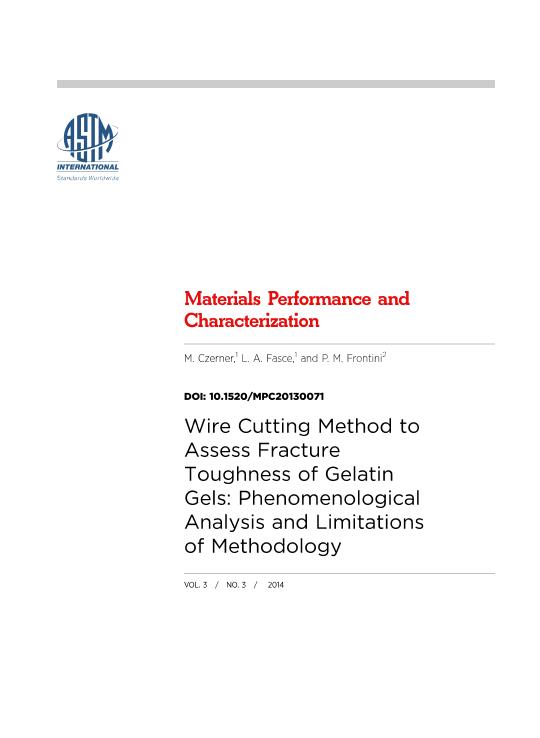Artículo
Wire cutting method to assess fracture toughness of gelatin gels: Phenomenological analysis and limitations of methodology
Fecha de publicación:
17/01/2014
Editorial:
ASTM International
Revista:
Materials Performance and Characterization
ISSN:
2165-3992
Idioma:
Inglés
Tipo de recurso:
Artículo publicado
Clasificación temática:
Resumen
In this work the performance of the wire cutting method for determining the fracture toughness, Gc, of gelatin hydrogels is assessed. In this method, wires of different diameters are pushed into a sample while the force and displacement are continuously recorded. The cutting action reaches a steady state, in which fracture propagation, deformation, and friction occur simultaneously. The method implies a linear relationship between the steady-state cutting force per unit sample width and the wire diameter, of which the y-intercept is Gc. Several gel samples differing in gelatin concentration, source (bovine or porcine), solvent (water or water–glycerol mixture), and crosslink type (physical or chemical induced by glutaraldehyde) were tested at different rates. Post-mortem fracture surfaces examined via optical microscopy displayed four different morphologies depending on the gel formulation, cutting rate, and wire diameter: I, striated; II, with one or two oblique straight lines; III, with rhombus-like figures; and IV, with material pull-out. A direct relationship between the developed fracture surface morphology and the method performance existed. One necessary condition for obtaining the linear relationship is a unique fracture surface morphology remaining for all of the wires utilized in the determination. The method is invalid if the fracture surface morphology changes with changing wire diameter, abnormal crack path deflection takes place, or material pull-out occurs as a result of adhesion effects. The applicability of the method seems to be not constrained to physical gels. An appropriate cutting rate and wire diameter have to be selected in order for a unique fracture surface morphology to be achieved. In such cases, reasonable Gc values were obtained from the y-intercept of the best linear fit of experimental data. Gc increased with increasing gelatin concentration, Bloom number, and solvent viscosity. Moreover, Gc was greater when a rhombus-like pattern was induced rather than other morphology due to greater crack path tortuosity.
Palabras clave:
Soft Materials
,
Gelatin Gels
,
Wire Cutting Method
,
Fracture Toughness
Archivos asociados
Licencia
Identificadores
Colecciones
Articulos(CCT - MAR DEL PLATA)
Articulos de CTRO.CIENTIFICO TECNOL.CONICET - MAR DEL PLATA
Articulos de CTRO.CIENTIFICO TECNOL.CONICET - MAR DEL PLATA
Articulos(INTEMA)
Articulos de INST.DE INV.EN CIENCIA Y TECNOL.MATERIALES (I)
Articulos de INST.DE INV.EN CIENCIA Y TECNOL.MATERIALES (I)
Citación
Czerner, Marina; Fasce, Laura Alejandra; Frontini, Patricia Maria; Wire cutting method to assess fracture toughness of gelatin gels: Phenomenological analysis and limitations of methodology; ASTM International; Materials Performance and Characterization; 3; 3; 17-1-2014; 448-468
Compartir
Altmétricas




